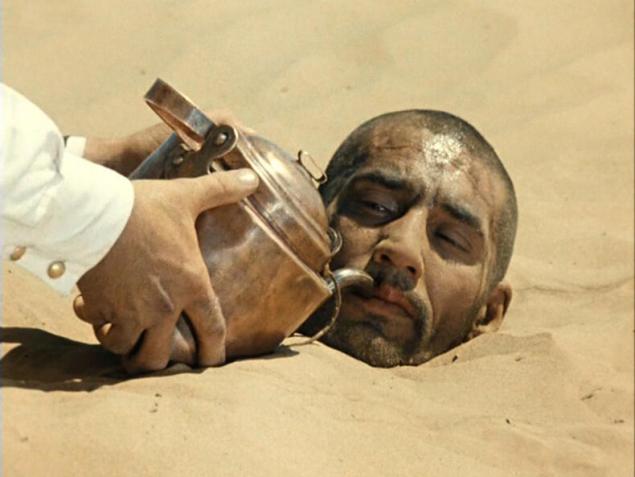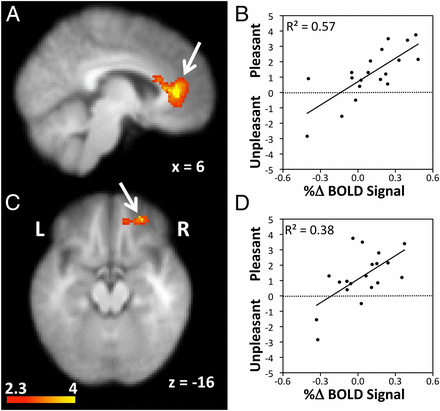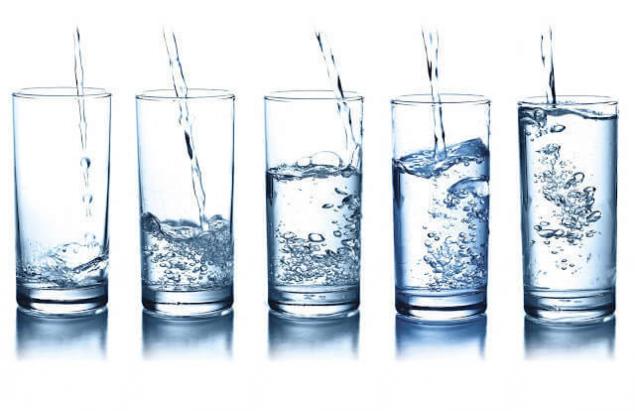716
Method of test sip: drink in joy
In healthy nutrition course, we understood that the amount of fluid necessary - is the amount of variability. Thus, it depends on the body weight, the amount of sodium in food, type of food, physical activity, temperature, physical activity, and other factors. But we have a mechanism for the regulation of water balance - a thirst
. Thirst - a set of feelings, expressed in the irresistible desire to drink the water and cause-specific behavioral responses. Scientific studies have shown that intake of fluid on the background of its loss leads to a good feeling, and drinking excess fluid - unpleasant sensations. In this article we look at how the system works and whether it is possible to rely on it.

sip test method.
Method of test sip: keep a bottle near him. If you suddenly feel thirsty (or if you thought that this thirst), then sipped a mouthful and ostanavlivaetets. If you feel pleasure and lust was the expression, the drink is to drink in and enjoy the feeling of thirst.
If the first drink "does not go", it is necessary to dismiss the bottle and return to it later. Check-important - to feel emotion after the first sip. The key to proper use, in general, the obvious method - is the ability to listen to the signals of your own body awareness.
Despite your doubts, this mechanism is very precise and your brain is perfectly able to calculate the amount of water needed by the body. On the neurophysiological mechanisms of this process and will this article.
Of course, in a number of diseases the normal sense of thirst may be impaired. There are situations when thirst is broken: it is excessive thirst (polydipsia) and impaired thirst (hypodipsia). For example, in schizophrenia patients drink a lot more water than you need, which can lead to violations of water-salt balance.
Osmoreceptors center and thirst.
So, how the brain calculates how much to drink? As fluid loss varies blood osmolality (salt content therein). In the brain, a number of units have special cells which are osmoreceptors i.e. perceived changes in osmolarity.

Brain osmoreceptors simultaneously control the secretion of the hormone vasopressin (which slows down the increase in urine output) and the emergence of a sense of thirst. Upon excitation of these neurons formed blood hyperosmolar thirst feeling and motivation that determines search and receive the oxen, and when excited gipoosmolyarnoy blood there is a feeling that determines the search for and the use of salt, salt motivation.
An important role in this process is the ventral terminal plate (the ventral lamina terminalis), which is associated with cerebral blood flow, cingulate cortex and the insula.
Neurons center drinking (thirst center) vo found many areas of the hypothalamic region: perifornikalnoy in the area between the fornix and mamillary bodies, as well as the area of the paraventricular and supraoptic nuclei of the anterior hypothalamus. thirst Center also includes subfornical organ vascular body endplate and the medial preoptic nucleus.
Such broad representation osmoreceptors in brain structures points to strengthen control over the condition of blood osmotic pressure. Neurons of supraoptic and paraventricular nuclei of the hypothalamus is closely associated with their processes with other neurons limbikoretikulyarnyh brain and the cortex of the brain.

Pleasure at replenishing thirst.
The key to understanding the method of test pharynx, is an indisputable fact that filling the true thirst for fun. The fact that we mistakenly perceive thirst, interpreting it differently. We can be confused with hunger, but very often confuse it with stress.
Upon activation of the sympathetic system is suppressed the work of the salivary glands and dry mouth (it is understandable why a glass of water give the speaker?). Oblique waves speakers during and especially at the beginning of speech, swallowing the water, that is a temporary polydipsia speakers, due, apparently, the fact that the lack of confidence or fear of failure strongly inhibits, reduces saliva, the mouth as a result of this is dry and there is a feeling of the local thirst .
So, the wetting of water or ice, and eliminates false satisfies thirst without adding to the body of excess fluid. This is due to the fact that thirst has a locking mechanism, which I will discuss below.
In the meantime, let's see, where is the fun when you pte. Pleasure at replenishing thirst localized in the anterior cingulate and orbitofrontal (orbito-frontal) area. The greater water scarcity, the expression and the longer the pleasure of receiving water.

Pleasure at replenishing the true thirst
Satisfying thirst
Primary satisfied - this signals from the nerves of the esophagus and pharynx, when ingesting water (5 minutes). Secondary satisfaction of thirst - a change in the composition of blood, when the liquid is metabolized (25 minutes). Humidification oral eliminates false thirst. When a true thirst for moisture can only soften it, but not eliminated.
Stimulation of 7, 9 and 10 pairs of cranial nerves quickly reaches the thirst center and eliminate it. Thus thirst disappears without waiting blood osmolarity changes, as water begins to be sucked in 5-10 minutes and be acquired from the stomach and the intestine only after 25 minutes. Therefore, pharynx and esophagus are very important for their thirst. If you drink slightly delaying the water, in small sips, and savoring, it is more effective elimination of thirst.
That is why, if administered to a human water gavage (bypassing the mouth, pharynx and esophagus), he feels thirst quenching only 25 minutes! Unlike many other species, man is not necessary to stretch the stomach water to thirst disappeared.
Displeasure if not thirsty or needs.
I think many of you who have a little listen to the body, knows the discomfort, if you drink without desire. Often many drink, "because you have 3-liter" or reading a book "all diseases of dehydration».
Alas, the excess water will not make you good. In our body there is a special mechanism that stops the drinking process, there is a feeling of "tasteless" water, discontent, or even disgust. Discomfort associated with activation of the insula, amygdala, and periaqueductal gray. Also included is the motor cortex, which causes us to stop drinking water.

Displeasure and negative emotions while drinking extra water!
Excess drinking a fresh water - it is bad enough for the body, especially in pristine condition. Fresh water can lead to excess sodium deficiency (particularly at high exercise and sweating). Sodium in ancient times was quite scarce compound, so our body has mechanisms that protect against its loss. That is why the feeling of thirst can often be lost, especially in conditions of chronic stress (when the logic of the organism it is better to dehydration than the loss of sodium). But a test sip of water activates the latent thirst and there is a feeling of pleasure.
Test gulp - do regularly
! Even if we had a drink before elimination of thirst, we made up for the balance not entirely. The body works on the calibration method: first, it makes up 50-80% of the liquid once the deficit, and then slowly and precisely gets the rest.
Remember, we said that the feeling of thirst disappears even before the water began to be absorbed from the stomach. Such a gradual recovery of fluid loss is more natural for us. So do not rush to drink just a huge amount of liquid, it is better to do it gradually, reducing the volume of alcohol consumed.
The central factor leading to dehydration, a condition called "dehydration of their own accord." Several of the study it was found that when test subjects people to engage in physical activity in a hot climate, and could drink water in unlimited quantities, they drank only about 50% of the amount of fluid they have lost due to sweating.

Therefore it is necessary to periodically test sip, rather than delaying the bottle away, if you once had a drink. No, once the deficit is not fully fill!
Author: Andrew Beloveshkin
. Thirst - a set of feelings, expressed in the irresistible desire to drink the water and cause-specific behavioral responses. Scientific studies have shown that intake of fluid on the background of its loss leads to a good feeling, and drinking excess fluid - unpleasant sensations. In this article we look at how the system works and whether it is possible to rely on it.

sip test method.
Method of test sip: keep a bottle near him. If you suddenly feel thirsty (or if you thought that this thirst), then sipped a mouthful and ostanavlivaetets. If you feel pleasure and lust was the expression, the drink is to drink in and enjoy the feeling of thirst.
If the first drink "does not go", it is necessary to dismiss the bottle and return to it later. Check-important - to feel emotion after the first sip. The key to proper use, in general, the obvious method - is the ability to listen to the signals of your own body awareness.
Despite your doubts, this mechanism is very precise and your brain is perfectly able to calculate the amount of water needed by the body. On the neurophysiological mechanisms of this process and will this article.
Of course, in a number of diseases the normal sense of thirst may be impaired. There are situations when thirst is broken: it is excessive thirst (polydipsia) and impaired thirst (hypodipsia). For example, in schizophrenia patients drink a lot more water than you need, which can lead to violations of water-salt balance.
Osmoreceptors center and thirst.
So, how the brain calculates how much to drink? As fluid loss varies blood osmolality (salt content therein). In the brain, a number of units have special cells which are osmoreceptors i.e. perceived changes in osmolarity.

Brain osmoreceptors simultaneously control the secretion of the hormone vasopressin (which slows down the increase in urine output) and the emergence of a sense of thirst. Upon excitation of these neurons formed blood hyperosmolar thirst feeling and motivation that determines search and receive the oxen, and when excited gipoosmolyarnoy blood there is a feeling that determines the search for and the use of salt, salt motivation.
An important role in this process is the ventral terminal plate (the ventral lamina terminalis), which is associated with cerebral blood flow, cingulate cortex and the insula.
Neurons center drinking (thirst center) vo found many areas of the hypothalamic region: perifornikalnoy in the area between the fornix and mamillary bodies, as well as the area of the paraventricular and supraoptic nuclei of the anterior hypothalamus. thirst Center also includes subfornical organ vascular body endplate and the medial preoptic nucleus.
Such broad representation osmoreceptors in brain structures points to strengthen control over the condition of blood osmotic pressure. Neurons of supraoptic and paraventricular nuclei of the hypothalamus is closely associated with their processes with other neurons limbikoretikulyarnyh brain and the cortex of the brain.

Pleasure at replenishing thirst.
The key to understanding the method of test pharynx, is an indisputable fact that filling the true thirst for fun. The fact that we mistakenly perceive thirst, interpreting it differently. We can be confused with hunger, but very often confuse it with stress.
Upon activation of the sympathetic system is suppressed the work of the salivary glands and dry mouth (it is understandable why a glass of water give the speaker?). Oblique waves speakers during and especially at the beginning of speech, swallowing the water, that is a temporary polydipsia speakers, due, apparently, the fact that the lack of confidence or fear of failure strongly inhibits, reduces saliva, the mouth as a result of this is dry and there is a feeling of the local thirst .
So, the wetting of water or ice, and eliminates false satisfies thirst without adding to the body of excess fluid. This is due to the fact that thirst has a locking mechanism, which I will discuss below.
In the meantime, let's see, where is the fun when you pte. Pleasure at replenishing thirst localized in the anterior cingulate and orbitofrontal (orbito-frontal) area. The greater water scarcity, the expression and the longer the pleasure of receiving water.

Pleasure at replenishing the true thirst
Satisfying thirst
Primary satisfied - this signals from the nerves of the esophagus and pharynx, when ingesting water (5 minutes). Secondary satisfaction of thirst - a change in the composition of blood, when the liquid is metabolized (25 minutes). Humidification oral eliminates false thirst. When a true thirst for moisture can only soften it, but not eliminated.
Stimulation of 7, 9 and 10 pairs of cranial nerves quickly reaches the thirst center and eliminate it. Thus thirst disappears without waiting blood osmolarity changes, as water begins to be sucked in 5-10 minutes and be acquired from the stomach and the intestine only after 25 minutes. Therefore, pharynx and esophagus are very important for their thirst. If you drink slightly delaying the water, in small sips, and savoring, it is more effective elimination of thirst.
That is why, if administered to a human water gavage (bypassing the mouth, pharynx and esophagus), he feels thirst quenching only 25 minutes! Unlike many other species, man is not necessary to stretch the stomach water to thirst disappeared.
Displeasure if not thirsty or needs.
I think many of you who have a little listen to the body, knows the discomfort, if you drink without desire. Often many drink, "because you have 3-liter" or reading a book "all diseases of dehydration».
Alas, the excess water will not make you good. In our body there is a special mechanism that stops the drinking process, there is a feeling of "tasteless" water, discontent, or even disgust. Discomfort associated with activation of the insula, amygdala, and periaqueductal gray. Also included is the motor cortex, which causes us to stop drinking water.

Displeasure and negative emotions while drinking extra water!
Excess drinking a fresh water - it is bad enough for the body, especially in pristine condition. Fresh water can lead to excess sodium deficiency (particularly at high exercise and sweating). Sodium in ancient times was quite scarce compound, so our body has mechanisms that protect against its loss. That is why the feeling of thirst can often be lost, especially in conditions of chronic stress (when the logic of the organism it is better to dehydration than the loss of sodium). But a test sip of water activates the latent thirst and there is a feeling of pleasure.
Test gulp - do regularly
! Even if we had a drink before elimination of thirst, we made up for the balance not entirely. The body works on the calibration method: first, it makes up 50-80% of the liquid once the deficit, and then slowly and precisely gets the rest.
Remember, we said that the feeling of thirst disappears even before the water began to be absorbed from the stomach. Such a gradual recovery of fluid loss is more natural for us. So do not rush to drink just a huge amount of liquid, it is better to do it gradually, reducing the volume of alcohol consumed.
The central factor leading to dehydration, a condition called "dehydration of their own accord." Several of the study it was found that when test subjects people to engage in physical activity in a hot climate, and could drink water in unlimited quantities, they drank only about 50% of the amount of fluid they have lost due to sweating.

Therefore it is necessary to periodically test sip, rather than delaying the bottle away, if you once had a drink. No, once the deficit is not fully fill!
Author: Andrew Beloveshkin























